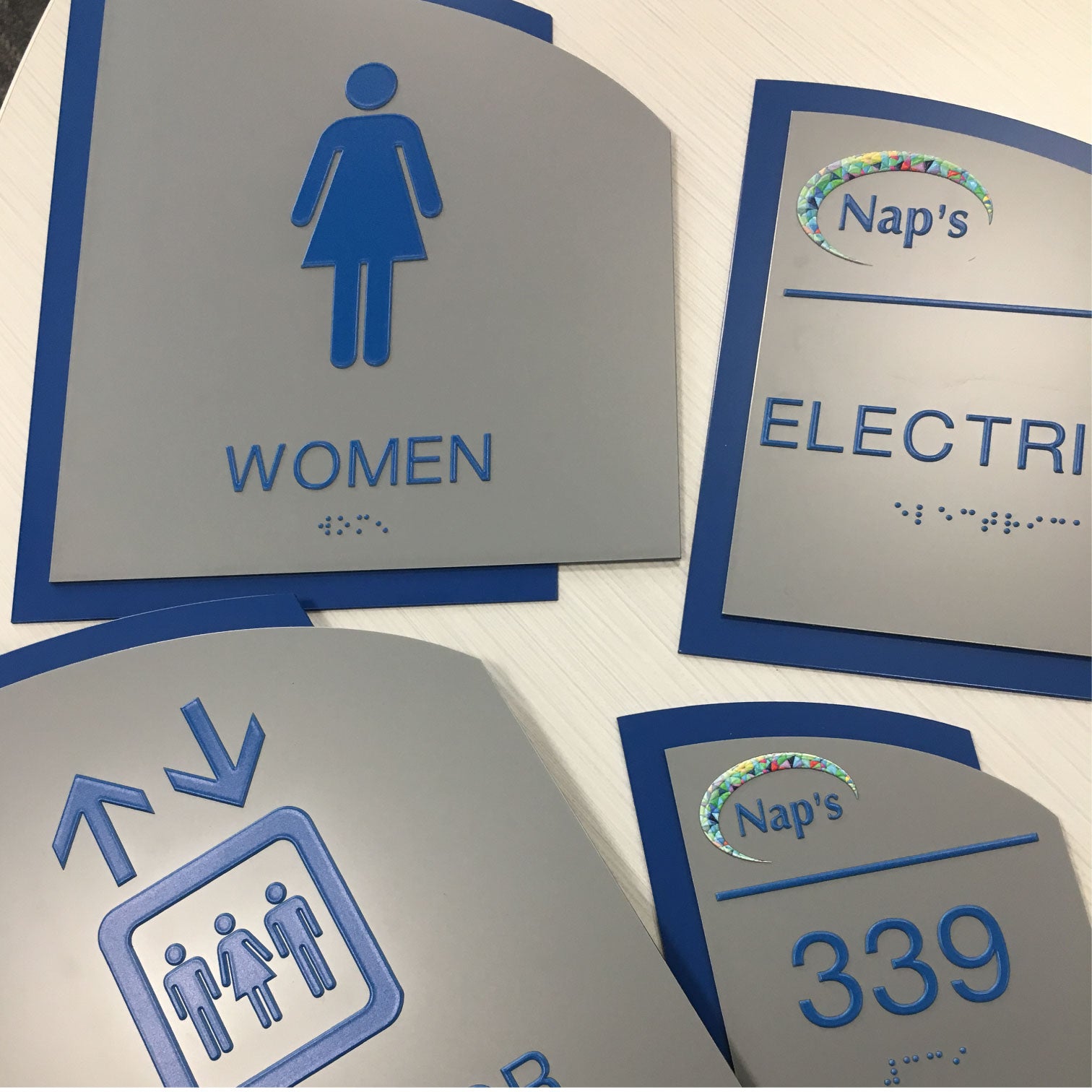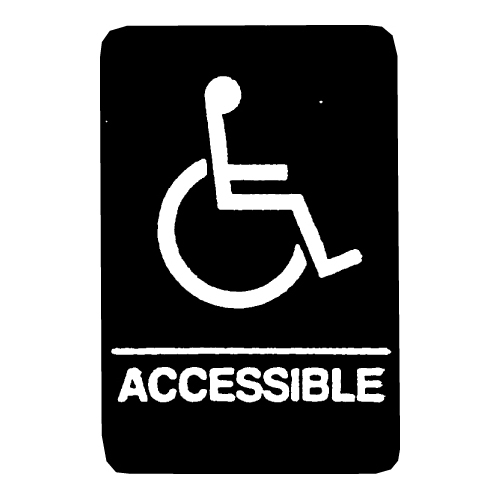Recognizing the Regulations Behind ADA Signs
Recognizing the Regulations Behind ADA Signs
Blog Article
ADA Signs: Guaranteeing Accessibility and Compliance in Public Spaces
ADA signage plays an important function in assuring accessibility and compliance within public spaces, considerably contributing to a comprehensive setting for individuals with impairments. As we check out the nuances of ADA signage, from tactile features to make ins and outs, it's essential to think about how these elements coalesce to copyright the civil liberties of all individuals.
Significance of ADA Signs
In contemporary society, the relevance of ADA signs extends past simple conformity with legal requireds to personify a dedication to inclusivity and accessibility for all individuals. These indicators are crucial in developing settings where people with specials needs can browse public spaces with the very same convenience and freedom as those without handicaps. By supplying clear and standard information, ADA signs makes sure that every person can access facilities, solutions, and information without barriers.
The value of ADA signs lies in its capacity to boost the lifestyle for people with specials needs by advertising equal gain access to. It removes the challenges that could otherwise impede their capability to participate totally in neighborhood life. In addition, these indications offer as visible indications of a company's dedication to variety and equality, showing wider societal values that promote the rights and self-respect of all individuals.
Additionally, ADA signage plays a vital duty in public safety and security. By assisting individuals to exits, toilets, and other important facilities, it makes sure that all people, no matter physical capability, can leave securely during emergencies. In summary, ADA signs is not simply a regulatory demand but an effective tool for cultivating a fair and inclusive society.
Trick Components of Conformity

Placement is important; signs have to be set up in areas that are conveniently visible and reachable. Generally, signs needs to be mounted between 48 and 60 inches from the ground to make certain access for both standing and wheelchair individuals. Tactile aspects, such as Braille, are important for people with aesthetic disabilities, supplying crucial information in a non-visual format.
High-contrast colors in between the message and history are essential to enhance readability for individuals with low vision. The ADA mandates details contrast ratios to guarantee clarity. In addition, character size is a vital consideration, with minimum elevation needs dictated by the checking out range to make certain readability from numerous angles.
Layout Considerations for Ease Of Access
Creating easily accessible signs needs a meticulous technique to guarantee it satisfies the demands of all individuals, especially those with specials needs. This involves taking into consideration numerous layout aspects that improve readability and usability. Trick factors consist of the choice of typeface, color comparison, and responsive features. Fonts should be sans-serif, with easy and clear letterforms, to promote simple analysis. The size of the text is equally vital, with ADA guidelines suggesting a minimal elevation based upon seeing distance to ensure legibility.
Contrasting colors in between text and background are important for exposure, particularly for individuals with aesthetic impairments. In addition, responsive aspects, such as Braille and raised characters, are crucial for individuals who are blind or have low vision.
Furthermore, the positioning of signs plays a significant duty in ease of access. Signs should be mounted in places that are conveniently obtainable and unhampered. Guaranteeing that signs is placed at ideal elevations and angles enables all users, including those using mobility devices, to engage with them efficiently.
Typical Mistakes to Prevent

One more common mistake is the wrong placement of signage. ADA standards specify specific elevation and location requirements to guarantee that indicators are reachable and conveniently visible by all people, consisting of those utilizing wheelchairs. Ignoring these standards not just hinders availability but also takes the chance of non-compliance with lawful criteria.
Furthermore, not enough comparison in between message and background is a frequent oversight. Sufficient comparison is vital for readability, particularly for people with low vision. Designers often pick colors that are visually enticing however lack the required contrast, providing the text hard to discern.
Last but not least, some designers stop working to incorporate responsive elements, such as Braille, which are important for people who are blind. Omitting these functions not just causes non-compliance with investigate this site ADA laws yet hop over to these guys also restricts access for a section of the populace that counts on tactile information.
Future Trends in Signs
Innovations in technology and enhancing understanding of inclusivity are forming the future trends in signage design. As culture becomes extra aware of varied demands, the combination of smart modern technologies into signs is gaining grip. Digital signage, for circumstances, is progressing to include real-time updates and interactive attributes, which can be vital in giving dynamic information in public spaces. These indicators commonly include touch displays or gesture-based controls, enabling individuals to browse material tailored to their specific demands.
An additional emerging fad is the use of enhanced reality (AR) to boost individual experience. AR-enabled signage can overlay electronic information onto the physical setting, offering aesthetically impaired people with auditory or haptic comments. ADA Signs. This technology not only boosts access yet also produces an engaging experience for all individuals
Sustainability is additionally a significant aspect affecting signage patterns. Eco-friendly materials and energy-efficient illumination solutions are being prioritized to line up with international ecological goals. Developments in materials scientific research are leading to the growth of even more weather-resistant and long lasting indications.
Verdict
ADA signs plays a vital role in ensuring availability and conformity within public rooms by including responsive components, high-contrast shades, and strategic placement. The adherence to ADA requirements not just assists in this page secure navigating for people with handicaps yet additionally signifies an organization's dedication to diversity and inclusivity. By avoiding typical errors and accepting future patterns, public areas can continue to advance these worths, ensuring that the rights and dignity of all individuals are respected and upheld.
ADA signs plays an essential role in guaranteeing accessibility and conformity within public rooms, dramatically adding to a comprehensive setting for people with impairments. As we check out the subtleties of ADA signs, from responsive features to create intricacies, it's crucial to take into consideration just how these aspects coalesce to promote the legal rights of all individuals.In contemporary culture, the value of ADA signage extends past mere conformity with legal mandates to personify a commitment to inclusivity and accessibility for all people. By providing standardized and clear information, ADA signs ensures that every person can access facilities, solutions, and info without obstacles.
ADA signage plays a vital duty in guaranteeing access and compliance within public rooms by integrating responsive aspects, high-contrast shades, and tactical positioning. (ADA Signs)
Report this page